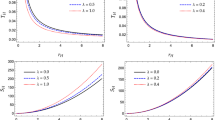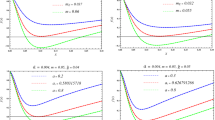Appendix: Magnetized Kerr–Newman spacetime
This appendix is mainly included for the purpose of completeness with most of the definitions taken from Ref. [8]. For the magnetized Kerr–Newman metric
$$\begin{aligned} ds^{2}=H\left[ -fdt^{2}+R^{2}\left( \frac{dr^{2}}{\Delta }+d\theta ^{2}\right) \right] +\frac{\Sigma \sin ^{2}\theta }{HR^{2}}(d\phi -\omega dt)^{2}, \end{aligned}$$
we define the following quantities
$$\begin{aligned} H=1+\frac{H_{(1)}B+H_{(2)}B^{2}+H_{(3)}B^{3}+H_{(4)}B^{4}}{R^{2}}, \end{aligned}$$
with
$$\begin{aligned} H_{(1)}= & {} 2aqr\sin ^{2}\theta -2p\left( r^{2}+a^{2}\right) \cos \theta , \\ H_{(2)}= & {} \frac{1}{2}\left[ \left( r^{2}+a^{2}\right) ^{2}-a^{2}\Delta \sin ^{2}\theta \right] \sin ^{2}\theta +\frac{3}{2}q^{2}\left( a^{2}+r^{2}\cos ^{2}\theta \right) , \\ H_{(3)}= & {} -pa^{2}\Delta \sin ^{2}\theta \cos \theta -\frac{qa\Delta }{2r} \left[ r^{2}\left( 3-\cos ^{2}\theta \right) \cos ^{2}\theta +a^{2}\left( 1+\cos ^{2}\theta \right) \right] \\&+\,\frac{aq\left( r^{2}+a^{2}\right) ^{2}\left( 1+\cos ^{2}\theta \right) }{2r}+ \frac{1}{2}p\left( r^{4}-a^{4}\right) \sin ^{2}\theta \cos \theta \\&+\,\frac{q{\overline{q}}a\left[ \left( 2r^{2}+a^{2}\right) \cos ^{2}\theta +a^{2}\right] }{2r}-\frac{1}{2}p{\overline{q}}^{2}\left( r^{2}+a^{2}\right) \cos ^{3}\theta , \\ H_{(4)}= & {} \frac{1}{16}\left( r^{2}+a^{2}\right) ^{2}R^{2}\sin ^{4}\theta +\frac{1}{4} Ma^{2}r\left( r^{2}+a^{2}\right) \sin ^{6}\theta \\&+\,\frac{1}{4}Ma^{2}{\overline{q}}^{2}r\left( \cos ^{2}\theta -5\right) \sin ^{2}\theta \cos ^{2}\theta +\frac{1}{4}Ma^{2}r\left( r^{2}+a^{2}\right) \sin ^{6}\theta \\&+\,\frac{1}{4}M^{2}a^{2}\left[ r^{2}\left( \cos ^{2}\theta -3\right) ^{2}\cos ^{2}\theta +a^{2}\left( 1+\cos ^{2}\theta \right) ^{2}\right] \\&+\,\frac{1}{8}{\overline{q}} ^{2}\left( r^{2}+a^{2}\right) \left( r^{2}+a^{2}+a^{2}\sin ^{2}\theta \right) \sin ^{2}\theta \cos ^{2}\theta \\&+\,\frac{1}{16}{\overline{q}}^{4}\left[ r^{2}\cos ^{2}\theta +a^{2}\left( 1+\sin ^{2}\theta \right) \right] \cos ^{2}\theta , \end{aligned}$$
where
$$\begin{aligned} {\overline{q}}^{2}=q^{2}+p^{2}. \end{aligned}$$
Also,
$$\begin{aligned} \omega =\frac{1}{\Sigma }\left[ \left( 2Mr-{\overline{q}}^{2}\right) a+\omega _{(1)}B+\omega _{(2)}B^{2}+\omega _{(3)}B^{3}+\omega _{(4)}B^{4}\right] \end{aligned}$$
with
$$\begin{aligned} \omega _{(1)}= & {} -2qr\left( r^{2}+a^{2}\right) +2ap\Delta \cos \theta , \\ \omega _{(2)}= & {} -\frac{3}{2}a{\overline{q}}^{2}\left( r^{2}+a^{2}+\Delta \cos ^{2}\theta \right) , \\ \omega _{(3)}= & {} 4qM^{2}a^{2}r\\&+\,\frac{1}{2}ap{\overline{q}}^{4}\cos ^{3}\theta + \frac{1}{2}qr\left( r^{2}+a^{2}\right) \left[ r^{2}-a^{2}+\left( r^{2}+3a^{2}\right) \cos ^{2}\theta \right] \\&+\,\frac{1}{2}ap\left( r^{2}+a^{2}\right) \left[ 3r^{2}+a^{2}-\left( r^{2}-a^{2}\right) \cos ^{2}\theta \right] \cos \theta \\&+\,\frac{1}{2}q{\overline{q}}^{2}r\left[ \left( r^{2}+3a^{2}\right) \cos ^{2}\theta -2a^{2}\right] +\frac{1}{2}ap{\overline{q}}^{2}\left[ 3r^{2}+a^{2}+2a^{2}\cos ^{2}\theta \right] \cos \theta \\&-\,aM{\overline{q}}^{2}\left( 2aq+pr\cos ^{3}\theta \right) +qM\left[ r^{4}-a^{4}+r^{2}\left( r^{2}+3a^{2}\right) \sin ^{2}\theta \right] \\&-\,apMr\left[ 2R^{2}+\left( r^{2}+a^{2}\right) \sin ^{2}\theta \right] \cos \theta ,\\ \omega _{(4)}= & {} \frac{1}{2}a^{3}M^{3}r\left( 3+\cos ^{4}\theta \right) -\frac{1}{16}a {\overline{q}}^{6}\cos ^{4}\theta \\&-\frac{1}{8}a{\overline{q}}^{4}\left[ r^{2}\left( 2+\sin ^{2}\theta \right) \cos ^{2}\theta +a^{2}\left( 1+\cos ^{4}\theta \right) \right] \\&+\,\frac{1}{16}a{\overline{q}}^{2}\left( r^{2}+a^{2}\right) \left[ r^{2}\left( 1-6\cos ^{2}\theta +3\cos ^{4}\theta \right) -a^{2}\left( a+\cos ^{4}\theta \right) \right] \\&-\,\frac{1}{4}a^{3}M^{2}{\overline{q}}^{2}\left( 3+\cos ^{4}\theta \right) +\frac{1}{4}aM^{2}\left[ r^{4}\left( 3-6\cos ^{2}\theta +3\cos ^{4}\theta \right) \right. \\&\left. +\,2a^{2}r^{2}\left( 3\sin ^{2}\theta -2\cos ^{4}\theta \right) -a^{4}\left( 1+\cos ^{4}\theta \right) \right] +\frac{1}{8}aM{\overline{q}}^{4}r\cos ^{4}\theta \\&+\,\frac{1}{8}aM{\overline{q}}^{2}r\cos ^{4}\theta \left[ 2r^{2}\left( 3-\cos ^{2}\theta \right) \cos ^{2}\theta -a^{2}\left( 1-3\cos ^{2}\theta -2\cos ^{4}\theta \right) \right] \\&+\,\frac{1}{8}aMr\left( r^{2}+a^{2}\right) \left[ r^{2}\left( 3+6\cos ^{2}\theta -\cos ^{4}\theta \right) -a^{2}\left( 1-6\cos ^{2}\theta -3\cos ^{4}\theta \right) \right] \end{aligned}$$
The electromagnetic vector potential is
$$\begin{aligned} A=\left( \Phi _{0}-\omega \Phi _{3}\right) dt+\Phi _{3}d\phi , \end{aligned}$$
(6.15)
where
$$\begin{aligned} \Phi _{0}=\frac{\Phi _{0}^{(0)}+\Phi _{0}^{(1)}B+\Phi _{0}^{(2)}B^{2}+\Phi _{0}^{(3)}B^{3}}{4\Sigma }, \end{aligned}$$
(6.16)
with
$$\begin{aligned} \Phi _{0}^{(0)}= & {} 4\left[ -qr\left( r^{2}+a^{2}\right) +ap\Delta \cos \theta , \right. \\ \Phi _{0}^{(1)}= & {} -6a{\overline{q}}^{2}\left( r^{2}+a^{2}+\Delta \cos ^{2}\theta \right) ,\\ \Phi _{0}^{(2)}= & {} -3q\left[ (r+2M)a^{4}-(r^{2}+4Mr+\Delta \cos ^{2}\theta )r^{3}\right. \\&+\,a^{2}\left( 2{\overline{q}}^{2}(r+2M)-6Mr^{2}-8M^{2}r \right. \\&-\left. \left. 3r\Delta \cos ^{2}\theta \right) \right] +3p\Delta \left[ 3ar^{2}+a^{3}+a(a^{2}+{\overline{q}}^{2}-r^{2})\cos ^{2}\theta \right] \cos \theta ,\\ \Phi _{0}^{(3)}= & {} -\frac{1}{2}a\left[ 4a^{4}M^{2}+a^{4}{\overline{q}}^{2}+12a^{2}M^{2} {\overline{q}}^{2}+2a^{2}{\overline{q}}^{4}\right. \\&+\,2a^{4}Mr-24a^{2}M^{3}r+4a^{2}M {\overline{q}}^{2}r \\&-\,24a^{2}M^{2}r^{2}-4a^{2}Mr^{3}-12M^{2}r^{4}-{\overline{q}} ^{2}r^{4}-6Mr^{5}\\&-\,6r\Delta \{2M\left( r^{2}+a^{2}\right) -{\overline{q}}^{2}r\}\cos ^{2}\theta \\&\left. +\,\Delta ({\overline{q}}^{4}-3{\overline{q}} ^{2}r^{2}+a^{2}\left( 4M^{2}+{\overline{q}}^{2}-6Mr\right) \cos ^{4}\theta \right] , \end{aligned}$$
Using \(\Delta (r_{+})=0\) and \(\Sigma (r_{+},\theta _{0})=r_{+}^{2}+a^{2}\) for fixed \(\theta =\theta _{0}=0\) we get
$$\begin{aligned} \Phi _{0}^{(0)}(r_{+,}\theta _{0})= & {} -4qr_{+}\left( r_{+}^{2}+a^{2}\right) ,\\ \Phi _{0}^{(1)}(r_{+,}\theta _{0})= & {} -6a{\overline{q}}^{2}\left( r_{+}^{2}+a^{2}\right) , \\ \Phi _{0}^{(2)}(r_{+,}\theta _{0})= & {} -3q\left[ (r_{+}+2M)a^{4}-\left( r_{+}^{5}+4Mr_{+}^{4}\right) \right. \\&\left. +\,a^{2}\left( 2{\overline{q}}^{2}(r_{+}+2M) -6Mr_{+}^{2}-8M^{2}r_{+}\right) \right] , \\ \Phi _{0}^{(3)}(r_{+,}\theta _{0})= & {} -\frac{1}{2}a\left[ 4a^{4}M^{2}+12a^{2}M^{2}{\overline{q}}^{2}+2a^{2}{\overline{q}} ^{4}+2a^{4}Mr_{+}-24a^{2}M^{3}r_{+}\right. \nonumber \\&\left. +\,4a^{2}M{\overline{q}}^{2}r_{+}-24a^{2}M^{2}r_{+}^{2}-4a^{2}Mr_{+}^{3}\right. \\&\left. -\,{\overline{q}}^{2}r_{+}^{4}-6Mr_{+}^{5}+a^{4}{\overline{q}}^{2} -12M^{2}r_{+}^{4}\right] . \end{aligned}$$
and
$$\begin{aligned} \Phi _{3}=\frac{\Phi _{3}^{(0)}+\Phi _{3}^{(1)}B+\Phi _{3}^{(2)}B^2+\Phi _{3}^{(3)}B^3}{R^{2}H} \end{aligned}$$
(6.17)
with
$$\begin{aligned} \Phi _{3}^{(0)}= & {} aqr\sin ^{2}\theta -p\left( r^{2}+a^{2}\right) \cos \theta , \\ \Phi _{3}^{(1)}= & {} \frac{1}{2}\left[ \Sigma \sin ^{2}\theta +3{\overline{q}} ^{2}\left( a^{2}+r^{2}\cos ^{2}\theta \right) \right] , \\ \Phi _{3}^{(2)}= & {} \frac{3}{4}aqr\left( r^{2}+a^{2}\right) \sin ^{4}\theta -\frac{3}{4} p\left( r^{2}+a^{2}\right) ^{2}\sin ^{2}\theta \cos \theta +3a^{2}pMr\sin ^{2}\theta \cos \theta \\&+\,\frac{3}{2}aqm\left[ r^{2}\left( 3-\cos ^{2}\theta \right) \cos ^{2}\theta +a^{2}\left( 1+\cos ^{2}\theta \right) \right] -\frac{3}{4}aq{\overline{q}}^{2}r\sin ^{2}\theta \cos ^{2}\theta \\&-\,\frac{3}{4}p{\overline{q}}^{2}\left[ \left( r^{2}-a^{2}\right) \cos ^{2}\theta +2a^{2}\right] \cos \theta , \\ \Phi _{3}^{(3)}= & {} \frac{1}{8}R^{2}\left( r^{2}+a^{2}\right) ^{2}\sin ^{4}\theta +\frac{1}{2 }a^{2}Mr\left( r^{2}+a^{2}\right) \sin ^{6}\theta \\&-\,\frac{1}{2}a^{2}{\overline{q}} ^{2}Mr\left( 5-\cos ^{2}\theta \right) \sin ^{2}\theta \cos ^{2}\theta \\&+\,\frac{1}{2}a^{2}M^{2}\left[ r^{2}\left( 3-\cos ^{2}\theta \right) ^{2}\cos ^{2}\theta +a^{2}\left( 1+\cos ^{2}\theta \right) ^{2}\right] \\&+\,\frac{1}{4}{\overline{q}} ^{2}\left( r^{2}+a^{2}\right) \left[ r^{2}+a^{2}+a^{2}\sin ^{2}\theta \right] \sin ^{2}\theta \cos ^{2}\theta \\&+\,\frac{1}{ 8}{\overline{q}}^{4}\left[ r^{2}\cos ^{2}\theta +a^{2}\left( 2-\cos ^{2}\theta \right) ^{2}\right] \cos ^{2}\theta , \end{aligned}$$




